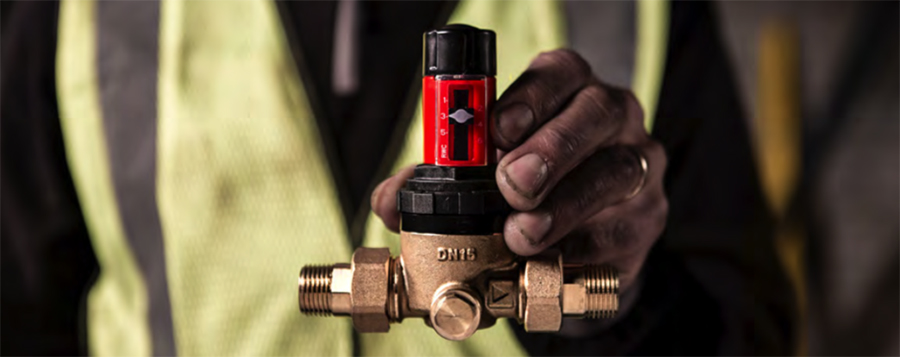Pressure Reducing Valve
A pressure reducing valve (PRV) functions, as the name suggests, by reducing a high inlet pressure at the inlet to a safer, lower water pressure at the outlet. The benefits of PRVs are multiple, as lower water pressures can decrease the amount of damage to heating systems, appliances, and buildings. Considering water pressure in the UK can vary from 1 bar to 20 bar, it is important that any risk to plumbing and heating systems is minimised to keep buildings and people safe.
As there are no regulations on water pressure in the UK there are no regulations for specifying PRVs, however, to reduce risk of unsafe water pressure it is highly recommended to specify them not only for domestic buildings, but especially for commercial buildings, where it is not uncommon to have sudden jumps in water pressure. PRVs ensure that the flow rate of water is not only correct for its intended purpose but that there is a safe water pressure that will allow other valves, such as thermostatic mixing valves, to function correctly as well. The individual valve that should be specified will depend heavily on the type of building, the water flow rate, and whether or not it is being used on a hot or cold-water supply.
The above article is an extract of "Do not get your ABCs confused – all you need to know about TMVs, PRVs and the Tenant Valve" published in the AT journal, issue 144, Winter and written by Richard Bateman, Product Marketing Manager, RWC.
--CIAT
[edit] Related articles on Designing Buildings
- A guide to installing thermostatic mixing valves: what, why and how.
- All you need to know about TMVs, PRVs and the Tenant Valve.
- Domestic hot water.
- Mechanical, electrical and plumbing MEP.
- Ofwat.
- Pipework defects, ventilation and airflow rates.
- Pipework.
- Pressure independent control valves.
- Pressure-relief valve.
- Pumps and dewatering equipment.
- Radiator.
- Tap.
- Thermostatic mixing valve.
- Types of valve.
- Types of water.
- Valve.
- Water safety plan WSP
- Water.
Featured articles and news
Infrastructure that connect the physical and digital domains.
Harnessing robotics and AI in challenging environments
The key to nuclear decommissioning and fusion engineering.
BSRIA announces Lisa Ashworth as new CEO
Tasked with furthering BSRIA’s impressive growth ambitions.
Public buildings get half a million energy efficiency boost
£557 million to switch to cleaner heating and save on energy.
CIOB launches pre-election manifesto
Outlining potential future policies for the next government.
Grenfell Tower Inquiry announcement
Phase 2 hearings come to a close and the final report due in September.
Progress from Parts L, F and O: A whitepaper, one year on.
A replicated study to understand the opinion of practitioners.
ECA announces new president 2024
Electrical engineer and business leader Stuart Smith.
A distinct type of countryside that should be celebrated.
Should Part O be extended to existing buildings?
EAC brands heatwave adaptation a missed opportunity.
Definition of Statutory in workplace and facilities management
Established by IWFM, BESA, CIBSE and BSRIA.
Tackling the transition from traditional heating systems
59% lack the necessary information and confidence to switch.
The general election and the construction industry
As PM, Rishi Sunak announces July 4 date for an election.
Eco apprenticeships continue help grow green workforce
A year after being recognised at the King's coronation.
Permitted development rights for agricultural buildings
The changes coming into effect as of May 21, 2024.























